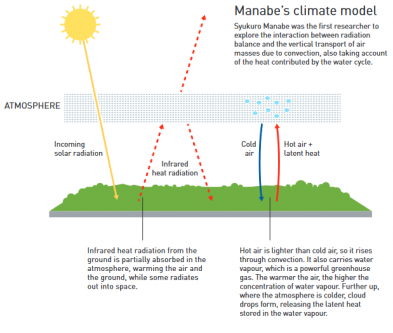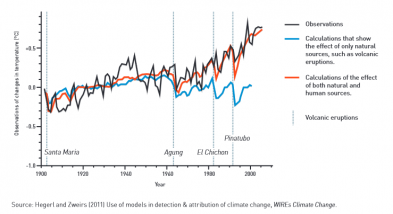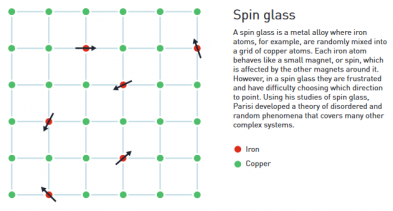Before we talk about this year's Nobel Prize in Physics, we need to clarify what we mean by physical systems in physics. In simple terms, the physical system is the thing that we can analyze with the formulas of physics. Just like an atom has electrons, protons and neutrons inside it - these are a physical system. There is water, fish and other things in a pond - the pond is also a physical system. What is around the physical system is called the environment. The physical system is sometimes affected by a few elements or components and sometimes its properties depend on many components. Many component dependent systems can be called complex physical systems.
This year's Nobel Prize has been awarded primarily for groundbreaking contributions to our understanding of complex physical systems. One of the two complex systems that has been awarded for its work is the Earth's atmosphere and the other is the structure or kinetic nature of a particular type of compound under special conditions (spin glass).
Japanese atmospheric physicist Sukuro Manabe and German oceanographer Klaus Hasselmann have won the Nobel Prize for their research on the dynamics of the Earth's climate and whether it is influenced by human activity. Manabe and Hasselman's work confirms that climate change is a fact and that not only are there natural causes, but we also have a lot of responsibility for our actions.
One of the reasons for the abundance of life on earth is its atmosphere. Under the influence of the greenhouse effect of the atmosphere, the absorbed heat from the sun to the earth's surface does not go out of the earth. As a result, the earth stays warm. But the high presence of carbon dioxide is able to take this process of keeping warm out of the ordinary. This was first observed by the 1901 Nobel laureate scientist Savante Arhenias. He was working on why the Ice Age happened on Earth. He finds a link to carbon dioxide here. He was able to show that if the amount of carbon dioxide in the atmosphere at that time ever dropped by half, the ice age would begin again. If the amount of carbon dioxide doubles, then the average temperature of the earth can increase by 5-6 degrees.
Sukuro Manabe, like Arhenius, has worked on how carbon dioxide can affect the climate. But their work style was different. Arhenius did not have a computer at the time, so he published his results from the amount of solar radiation absorbed and then the amount of heat emitted from the earth. And Manabe proposed a model through his research. In this model the warm air rising from the surface of the earth and the latent heat of the water vapor carried with it take place. The warmer the air, the more water vapor.

The Sukuro Manabe model was simple in nature, one-dimensional. In this model, published in 1986, he was able to show how the temperature of the earth would change for different amounts of different greenhouse gases (concentrations). He showed that the change in the amount of nitrogen and oxygen in the atmosphere does not cause a major change in the temperature of the earth, but there is a direct effect of the increase or decrease in the temperature of the earth with the decrease or increase in the amount of carbon dioxide. By varying the amount of carbon dioxide in his model, he came to the conclusion that doubling the amount of carbon dioxide would increase the earth's temperature by at least two degrees.
By proposing a special model in the 1970s, Klaus Hasselmann has made significant contributions to the long-term effects of climate change. He mainly worked with the sea and tides. Later he also started working on climate change. In his model, he seriously presents how a small change in an element of the environment affects the climate in the long run. For example, he was able to show how changes in our atmosphere would affect our oceans. One of the inspirations of his work was the Brownian motion given by Einstein.
After proposing the model, he began work on whether there was a man-made cause of climate change. And he does that with this model. He sees that a natural change caused by an event such as a volcanic eruption or a variation in solar radiation leaves a clear impression. In the same way, if any change is brought about by human actions, then there will be a sign or proof of it. He has introduced various methods to find out, the truth of which has been found through various observations.
His work proves that humans also have a hand in climate change. Notice the image below. Considering only natural causes, the temperature of the earth would change somehow. But if we consider both natural and man-made factors, what changes in temperature support the data we observe. That is, people cannot avoid their responsibility for climate change.

Now let's talk about the Italian theoretical physicist Giorgio Parisi. He received the Nobel Prize for providing an acceptable explanation for complex systems such as the atmosphere. However, his work world is not as vast as the Earth's atmosphere. His world is absolutely microscopic. The work for which he received the Nobel is a complex one. We know that all magnets have the same direction of magnetic spin, but not in the case of spin glass. In the case of spin glass a special system is born, which is called frosted system.

Not all spins in this system are in the same direction. Scientists are interpreting this issue in different ways at different times. One method is called replica trick. This trick was not so effective at first in explaining the frustrated system. Parisi used this replica trick to begin the process of finding acceptable mathematical solutions for spin glass systems. His research has influenced physics as well as other branches of science such as biology, neuroscience, machine learning, etc.
Manabe and Hasselman's Nobel Prize is a very important issue. Climate change is a very important issue and there will be a lot of messages, discussions, maybe even more than it was before, at least for a while with the Nobel Prize going into it. We can hope that it will now reach the heads of government of the industrialized nations, who may think and do their utmost to reduce carbon emissions.

